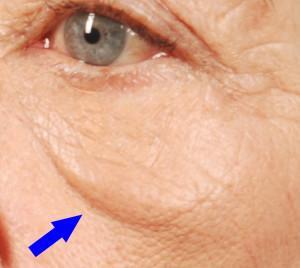The problem
A mound or pouch is seen below the eyelid, on the cheek. The term festoon refers to the apparent hanging of skin between two points.
Causes
The mound may consist of fluid (edema), soft tissue (skin, muscle, and fat), or both.
Fluid festoons may be seen at any age, even in youth, and people with flat cheekbones may be more likely to develop a festoon. They may be accentuated by an episode of swelling (allergy, drug reaction, trauma, post-surgery, or fluid overload).
Soft-tissue festoons can be the result of aging, as the skin loses some of its support. With time, the cheek fat and cheek bones may shrink, and the facial “ligaments” which support facial muscles can weaken or stretch. Specifically, the orbitomalar can weaken, allowing the surface of the cheek to appear to sag over the lower ligaments (zygomatic) that tend to be more firmly attached. In combination with the deflational effect of fat loss, the ligament stretching leads to a secondary bag (the primary bag is on the lower eyelid) or malar festoon (the term “malar” refers to the cheek).
Often seen with
Lower eyelid fat pouches (steatoblepharon), loose lower eyelid skin (dermatochalasis), loss of cheek and facial fat, flat cheekbone, sun, smoke and pollution exposure, and lower eyelid hollowing.
Not to be confused with
Lower eyelid fat bags (steatoblepharon).
What you see in the mirror
Pouches, bags, or skin folds on the cheeks, below the eyelid. It may appear puffy or fluid-like.
Malar bag (festoon)

